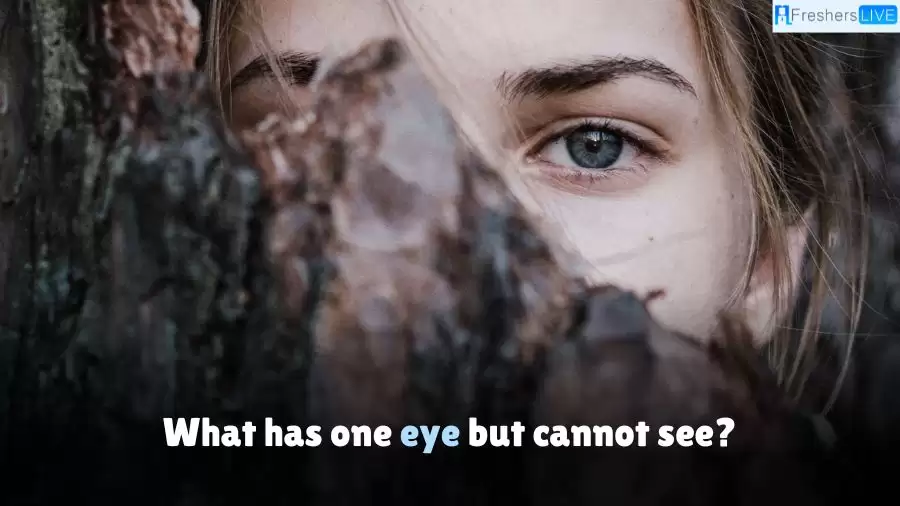Unlocking the Riddle of 'What Has One Eye But Cannot See?
by B Kishwar
Updated Jun 16, 2023

What are the Characteristics of A Well-Crafted Riddle?
A well-crafted riddle possesses several key characteristics that make it engaging and captivating. These characteristics include:
1. Intriguing and Thought-Provoking: A well-crafted riddle presents an enigmatic situation or question that piques curiosity and challenges the reader's intellect. It sparks interest and encourages the audience to ponder over possible solutions.
2. Clever Wordplay and Imagery: Riddles often utilize clever wordplay, metaphors, or figurative language to convey their message. They play with words, creating ambiguity and multiple meanings, which adds depth and complexity to the puzzle.
3. Concealed Clues and Misdirection: A well-crafted riddle skillfully conceals clues within its wording, requiring the reader to pay close attention and think critically. It may also incorporate misdirection or intentionally misleading elements to make the puzzle more challenging.
4. Balance of Difficulty: The ideal riddle strikes a balance between being too easy and too difficult. It should be challenging enough to engage the mind and require analytical thinking, but not so perplexing that it becomes frustrating or impossible to solve.
5. Unique and Original: A well-crafted riddle stands out by offering a unique and original concept or scenario. It avoids clichés and overused themes, ensuring a fresh and stimulating experience for the audience.
What are the Steps Involved in Solving What has one eye but cannot see Riddle?
Embark on a journey of unraveling the mystery behind the riddle, "What has one eye but cannot see?" In this intriguing puzzle, we will explore the steps involved in deciphering its enigmatic solution. By employing critical thinking and keen observation, we will navigate through the clues and clever wordplay to uncover the hidden truth. Join us as we delve into the depths of this riddle, step by step, unraveling its layers and ultimately discovering the surprising answer to this captivating conundrum.
Riddle - What has one eye but cannot see?
Enter the realm of intrigue with this captivating riddle that presents a scenario that seems impossible yet brimming with fascination. As you ponder the question, dare to explore unorthodox paths of thinking, liberating yourself from conventional boundaries. Embrace the challenge, relish the journey of intellectual exploration, and gradually untangle the captivating intricacies concealed within this enigmatic puzzle. Always remember, the solution lies well within your reach.
What Has One Eye But Cannot See Riddle - Unmasking the Secret
Unmask the secret hidden within the enigmatic riddle, "What has one eye but cannot see," as we embark on a quest to unravel its intriguing mystery. This captivating puzzle challenges our perception and invites us to delve into the realm of imagination and clever wordplay. In this exploration, we will shed light on the layers of symbolism and hidden clues, ultimately revealing the surprising answer. Prepare to be captivated as we unveil the truth behind this enigma and uncover the secret behind what possesses a single eye yet remains oblivious to the world.
Here is the Answer to What Has One Eye But Cannot See Riddle
Answer: A Needle
The answer to the riddle "What has one eye but cannot see?" is a needle. A needle typically has a small eye or hole at one end for threading thread or yarn, resembling an eye. However, as an inanimate object, a needle lacks the ability to perceive or see like living beings do. This riddle cleverly plays with the concept of an eye while highlighting the limitation of vision in certain objects.
Riddles provide a captivating and stimulating platform that engages our minds, igniting critical thinking, creativity, problem-solving, and language proficiency. By pushing us beyond traditional limits and fostering diverse perspectives, riddles offer more than mere entertainment; they nurture mental growth and intellectual satisfaction. Embrace the fascination of mystery, unravel intricate enigmas, and relish the exhilarating journey of unraveling riddles.
In What Ways Can Solving Riddles Boost Your Problem-Solving Skills?
Solving riddles can significantly enhance your problem-solving skills in various ways. Here are some of the key ways in which engaging with riddles can boost your problem-solving abilities:
1. Analytical Thinking: Riddles require careful analysis and evaluation of information. They prompt you to break down complex problems into smaller components, identify patterns, and examine details critically. This analytical thinking approach strengthens your problem-solving skills.
2. Creative Thinking: Riddles often demand thinking outside the box and to explore unconventional perspectives. They encourage creative problem-solving by challenging you to find alternative solutions and consider multiple angles. This fosters innovative thinking and expands your problem-solving repertoire.
3. Pattern Recognition: Riddles frequently incorporate patterns or sequences that need to be identified. By solving riddles, you train your mind to recognize and decipher patterns, which is a valuable skill in problem-solving across various domains.
4. Logical Reasoning: Riddles often involve logical reasoning to deduce the correct answer. They help sharpen your ability to evaluate information, make logical connections, and draw conclusions based on evidence. This logical reasoning skill is transferable to solving real-life problems effectively.
5. Attention to Detail: Riddles often include subtle clues and hints that require close observation and attention to detail. Engaging with riddles improves your ability to notice and extract relevant information from the given context, enhancing your problem-solving accuracy.
What Has One Eye But Cannot See Riddle - FAQs
The answer to the riddle "What has one eye but cannot see?" is a needle. A needle typically has a small eye or hole at one end for threading thread or yarn, resembling an eye. However, as an inanimate object, a needle lacks the ability to perceive or see like living beings do. This riddle cleverly plays with the concept of an eye while highlighting the limitation of vision in certain objects.







